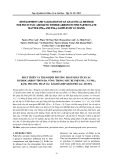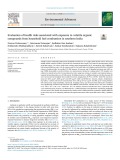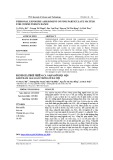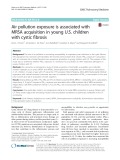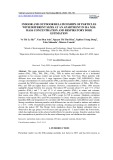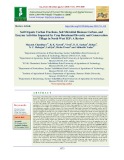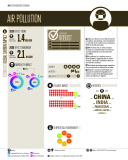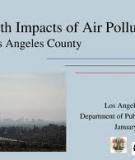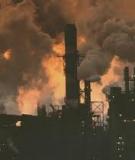
Fine particulate matter
-
In this study, we developed and validated a simple, rapid, and effective analytical method for the determination of 15 PAHs in fine dust samples (PM1.0 and PM2.5) by using a combination of ultrasonic extraction, solidphase extraction (SPE) clean-up, and GCMS/MS quantification. The validated method was applied to analyze PAHs in PM1.0 and PM2.5 samples collected from some areas in Bac Ninh Province, northern Vietnam.
 6p
6p  viengels
viengels
 25-08-2023
25-08-2023
 8
8
 3
3
 Download
Download
-
We hypothesize higher air pollution and fewer greenness exposures jointly contribute to metabolic syndrome (MetS), as mechanisms on cardiometabolic mortality. Methods: We studied the samples in the Chinese Longitudinal Healthy Longevity Survey. We included 1755 participants in 2012, among which 1073 were followed up in 2014 and 561 in 2017.
 12p
12p  viferrari
viferrari
 28-11-2022
28-11-2022
 12
12
 2
2
 Download
Download
-
The model achieved leave-one-location-out cross validated median absolute errors of 0.99, 0.76, 0.63, and 0.60 μg m3 for weekly, monthly, annual, and all-time exposure assessments, respectively. We further describe the model’s cross validated performance at different geographic regions in the United States, finding that it performs worse in the Western half of the country where there are less monitors.
 9p
9p  thebadguys
thebadguys
 15-01-2022
15-01-2022
 8
8
 0
0
 Download
Download
-
Volatile organic compounds (VOCs) from household cook-fuel use are a major public health concern in low and middle income countries (LMICs), but health risk assessments have largely been based on measurements of fine particulate matter. We report results from cooking period measurements of 21 non-methane VOCs (NMVOCs).
 10p
10p  thebadguys
thebadguys
 15-01-2022
15-01-2022
 14
14
 0
0
 Download
Download
-
This study aimed to assess the exposure of PM2.5 to motorcyclists and cyclists on some roads in Hanoi. Personal exposure samples were taken by the Airbeam sensor. Preliminary results showed that the exposure concentration of PM2.5 for cyclists (105 µg/m3 ) was higher than for motorcyclists (95 µg/m3 ) and level of PM2.5 in ambient air (34 µg/m3 ).
 9p
9p  nguaconbaynhay12
nguaconbaynhay12
 13-06-2021
13-06-2021
 13
13
 1
1
 Download
Download
-
The role of air pollution in increasing susceptibility to respiratory tract infections in the cystic fibrosis (CF) population has not been well described. We recently demonstrated that chronic PM2.5 exposure is associated with an increased risk of initial Pseudomonas aeruginosa acquisition in young children with CF.
 9p
9p  vimaine2711
vimaine2711
 26-03-2021
26-03-2021
 15
15
 2
2
 Download
Download
-
This paper presents data on the size distribution and concentration of particulate matters (PM0.1, PM0.5, PM1, PM2.5, PM10, TSP) in indoor and outdoor air at a residential apartment in two seasons (winter and summer) in Ha Noi, Viet Nam. These particles with different sizes were taken by 5 stage impactors (Nano sampler 3182, KINOMAX). Daily average concentrations of coarse particles (PM10) and fine particles (PM2.5) indoors and outdoors exceeded the WHO recommended values.
 11p
11p  cothumenhmong9
cothumenhmong9
 04-01-2021
04-01-2021
 16
16
 3
3
 Download
Download
-
Soil organic carbon (SOC) and its fractions (labile and non-labile) including particulate organic carbon (POC) and its components [coarse POC and fine POC], light fraction organic carbon (LFOC), readily oxidizable organic carbon, dissolved organic carbon (DOC) are important for sustainability of any agricultural production system as they govern most of the soil properties, and hence soil quality and health.
 28p
28p  gaocaolon5
gaocaolon5
 14-06-2020
14-06-2020
 20
20
 2
2
 Download
Download
-
Fine particulate matter (PM2.5) exposure is proved to be associated with illnesses, but the mechanism is not clear. Potential effects of PM2.5 on innate immunity have become a hotspot recently. Confronting PM2.5, macrophages are able to be activated and induce inflammatory responses. Whether PM2.5 exposure affects macrophage polarization and associated mechanisms remains to be further explored.
 10p
10p  vinasaki2711
vinasaki2711
 12-11-2019
12-11-2019
 12
12
 1
1
 Download
Download
-
First, recall that the SNIFF emissions inventory discussed above clearly indicates that industry is not the leading source of particulate emissions in Ciudad Juárez. Rather, the leading sources are vehicles, unpaved roads, and soil erosion (Table 1). Moreover, even leaving aside vehicles and soils, the single most important industrial subsector in terms of air pollution is brick kilns, not maquiladoras (Table 2). In fact, brick kilns emit more particulate matter than all other industrial plants combined.
 4p
4p  doipassword
doipassword
 01-02-2013
01-02-2013
 48
48
 3
3
 Download
Download
-
Unfortunately, to our knowledge, direct estimates of Mexican WTP for reductions in the health endpoints considered in this paper are not yet available. Therefore, we use WTP parameters (for adult respiratory symptom days, adult reduced activity days, asthma attacks, and chronic bronchitis) that are based on U.S. studies. But given that average income adjusted for purchasing power parity is approximately four times as high in the United States as in Mexico, Mexican WTP may be lower than American WTP. Cultural factors may also cause WTP in the two countries to differ.
 7p
7p  doipassword
doipassword
 01-02-2013
01-02-2013
 51
51
 3
3
 Download
Download
-
Primary pollutants are those in which the substance emitted is itself hazardous. Some primary pollutants also produce other dangerous substances after undergoing chemical reactions in the atmosphere, and these are known as secondary pollutants. Primary pollutants include the following substances. Particulates This includes dust, smoke, aerosols and haze - any finely divided airborne solid material.
 13p
13p  doipassword
doipassword
 01-02-2013
01-02-2013
 45
45
 3
3
 Download
Download
-
Both direct emission from fires and ash resuspension from burnt soils could be an important source of airborne PM10. This pyrogenic material, which is composed of organic matter, black carbon and inorganic material, is to a large extent present in the size range below 10 µm and so can be resuspended by wind [17]. Although the contribution to ambient aerosol from fire smoke will generally be episodic, in areas where there is a constant forest burning, the particulate emission from this source could be significant.
 35p
35p  saimatkhauroi
saimatkhauroi
 01-02-2013
01-02-2013
 58
58
 4
4
 Download
Download
-
Although data quantifying particulate emissions from construction and demolition work is scarce, some research carried out in USA gives an estimation for TSP of 2.5 tonnes/hectare/month in zones where large construction work is in progress. The quantity of particles emitted in each city from this source will depend on the type of construction in progress. These particles are mainly present in size fractions greater than 10µm. However, some fraction of the total amount is likely to be present as smaller particles. Also, some of this dust will be resuspended either by traffic or wind.
 291p
291p  saimatkhauroi
saimatkhauroi
 01-02-2013
01-02-2013
 54
54
 5
5
 Download
Download
-
Particulate emissions from road transport arise as direct emissions from vehicle exhausts, tyre and brake wear and resuspension of road dust. In urban areas, emissions from road transport are thought to be the major source of PM10. In general, diesel engine vehicles emit a greater mass of fine particulate matter, per vehicle, than petrol engines. Diesel emissions are mainly composed of soot particles, volatile hydrocarbons and some sulphate from the fuel sulphur.
 0p
0p  saimatkhauroi
saimatkhauroi
 01-02-2013
01-02-2013
 37
37
 3
3
 Download
Download
-
Particulate matter is arguably the most danger- ous component of automobile exhaust. Particles are small enough to infiltrate nasal, sinus, and bron- chial passages where they can accumulate and cal- cify. Fine PM can penetrate the deepest portions of the lungs and the very smallest particles can be absorbed into the bloodstream. In the nose, throat, and lungs, particulates act as extreme irritants. Exposure to even low levels of PM can cause na- sal congestion, sinusitis, throat irritation, cough- ing, wheezing, shortness of breath, and chest dis- comfort.
 67p
67p  saimatkhauroi
saimatkhauroi
 01-02-2013
01-02-2013
 35
35
 5
5
 Download
Download
-
Air pollution is a leading environmental threat to the health of urban populations overall and specifically to New York City residents. Clean air laws and regulations have improved the air quality in New York and most other large cities, but several pollutants in the city’s air are at levels that are harmful. This report provides estimates of the toll of air pollution on the health of New Yorkers. It focuses on 2 common air pollutants—fine particulate matter (PM2.5) and ozone (O3).
 40p
40p  saimatkhauroi
saimatkhauroi
 01-02-2013
01-02-2013
 54
54
 5
5
 Download
Download
-
Kanchha’s father immediately found a job in a brick kiln factory not very far from the city. These kilns produce highly concentrated amounts of fine particulate matter, which interact with other industrial and vehicle fumes over Kathmandu. Brick kilns use coal as their main fuel source, and this contributes to the air pollution in Kathmandu by pumping considerable quantities of sulfur dioxide (SO2) and other toxic substances into the atmosphere. After a few months, Kanchha’s father started to cough.
 101p
101p  saimatkhauroi
saimatkhauroi
 01-02-2013
01-02-2013
 42
42
 6
6
 Download
Download
CHỦ ĐỀ BẠN MUỐN TÌM








